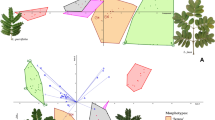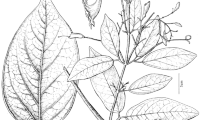Abstract
Leaf domatia, specialized structures on the undersides of leaves, appear to promote mutualism between plants and those mites that protect leaves from pathogenic fungi and small herbivorous arthropods. Their occurrence was surveyed on 425 plant species (368 native species and 57 species introduced from other regions of northeastern Asia), comprising 177 genera and 59 families of woody Dicotyledonae in the Korean flora. Domatia, primarily of tuft or pocket forms (84% of species), were present in vein axils on leaves of 152 species (36%) within 66 genera (37%) and 39 families (66%). Overall, we report leaf domatia in nine new families and 25 additional genera. Mites, primarily from families or suborders (e.g., Acaridida, Phytoseiidae, Tydeidae) in which arboreal representatives are primarily fungivorous or predaceous, were found in domatia on leaves of 78% of all species sampled. Domatia frequency depended upon both growth form and habit of species. They were especially common among tree species (55%), but less so on shrubs (20%) and woody vines (22%). Domatia were much more frequent on species of deciduous plants (40% of those sampled) than on evergreen species, of which only 10% had leaf domatia. This difference was consistent across a number of local deciduous and broadleaf evergreen forests in South Korea. The high frequency of leaf domatia in this survey indicates that plant-mite mutualism may be widespread in Korean plant communities. The floristic affinities of plants with domatia in Korea to those in other regions of East Asia, eastern North America, and Europe suggest that these plant-mite associations characterize the temperate broadleaf deciduous forest biome in the Northern Hemisphere.
Similar content being viewed by others
References
Anon. 1979. The Taxonomy of Families and Genera of Higher Plants in China. Institute of Botany, Academia Sinica. Science Publishing Company, Beijing. [in Chinese]
Bailey, L. H. & Bailey, E. Z., 1978. Hortus Third: A Concise Dictionary of Plants Cultivated in the United States and Canada. Macmillan, New York.
Beattie, A. J., 1985. The Evolutionary Ecology of Ant-Plant Mutualisms. Cambridge University Press, Cambridge.
Brouwer, Y. M. 1987. Domatia-morphology, anatomy and biological significance. Ph. D. thesis, University of Queensland, Australia.
Brouwer, Y. & Clifford, H., 1990. An annotated list of domatia-bearing species. Notes from the Jodrell Laboratory XII, pp. 1–33.
Ching, K. K. 1991. Temperature deciduous forests in East Asia. In: E.Röhrig & B.Ulrich (eds.), Ecosystems of the World 7. Temperate Deciduous Forests. Elsevier, London. pp. 539–555.
Cho, M. H. 1988. Illustrated Woody Plants of Korea. Forestry Research Institute. Seoul, Korea. [in Korean]
Cronquist, A., 1981. An Integrated System of Classification of Flowering Plants. Columbia University Press, New York.
Graham, A. 1972. Floristics and Paleofloristics of Asia and Eastern North America. Elsevier, New York.
Gregory, M. 1990. Additional records of occurrence of domatia. Notes from the Jodrell Laboratory XII, pp. 34–50.
Grostal, P. & O'Dowd, D. J., 1994. Plants, mites and mutualism: leaf domatia and the abundance and reproduction of mites onViburnum tinus (Caprifoliaceae). Oecologia, in press.
Hardin, J. W. 1992. Foliar morphology of the common trees of North Carolina and adjacent states. North Carolina Agricultural Research Service. Technical Bulletin 298. 135 pp.
Hayden, F. V. 1878. Report of the United States Geological Survey of the Territories. Volume VII. Government Printing Office, Washington. 366 pp., 65 plates.
Hong, S. C., Byun, S. H. & Kim, S. S. 1987. Colored Illustrations of Trees and Shrubs in Korea. Gye Myong Co., Seoul, Korea. [in Korean]
Hyland, B. P. M. 1982. A Revised Card Key to Rainforest Trees of North Queensland. Commonwealth Scientific & Industrial Research Organization, Melbourne, Australia.
Jacobs, M. 1966. On domatia-the viewpoints and some facts. 1. Academie Wetenschappen Amsterdam 69: 275–316.
Krantz, G. W. 1978. A Manual of Acarology. Second edition. Oregon State University Bookstore, Corvallis, Oregon, U.S.A.
Lee, E. B. & Byoung, U. O. 1991. Vascular plants and their distribution in Mt. Songni. Report of the Korean Association for the Conservation of Nature, No. 29, pp. 65–95. [in Korean]
Lee, T. B. 1989. Illustrated Flora of Korea. Hyang Mun Sa, Seoul, Korea. [in Korean]
Lee, T. C. & Moon, H. L. 1974. Vegetation of National Park, Mt. Naejangsan. Report of the Korean Association for the Conservation of Nature, No. 8, pp. 51–70. [in Korean]
Lee, T. C. & Kim, T. W. 1977. Vegetation of Mt. Jogeysan. Report of the Korean Association for the Conservation of Nature, No. 11, pp. 83–92. [in Korean]
Lee, W. T. 1987. The flora of Mt. T'aebaek. Report of the Korean Association for the Conservation of Nature, No. 25, pp. 43–57. [in Korean]
Lee, W. T. & Yang, J. Y. 1978. Studies on the distribution of vascular plants in the Korean Peninsula. Journal of Korean Plant Taxonomy 8: 1–33 [in Korean]
Lee, Y. N. & Oh, Y. C. 1982. Flora of Paigol Valley in Mt. Chiri. Report of the Korean Association for the Conservation of Nature, No. 21, pp. 25–37. [in Korean]
Lundströem, A. N. 1887. Von Domatien. Pflanzenbiologische Studien. II. Die Anpassung der Pflanzen an Thiere. Nova acta Regiae Societatis scientarum upsaliensis, Series 3, XIII. pp. 1–87.
Lundströem, A. N. 1890. Einige neueren Untersuchungen über Domatien. Botanisches Zentralblatt 41: 246–248.
O'Dowd, D. J. & Willson, M. F. 1989. Leaf domatia and mites on Australasian plants: ecological and evolutionary implications. Biological Journal of the Linnean Society 37: 191–236.
O'Dowd, D.J. & Willson, M. F. 1991. Associations between mites and leaf domatia. Trends in Ecology & Evolution 6: 179–182.
O'Dowd, D. J., Brew, C. R., Christopel, D.C. & Norton, R. A. 1990. Mite-plant associations from the Eocene of southern Australia. Science 252: 99–101.
Oh, J. G. 1991. Phytosociological studies on the forest vegetation of Kŭmo Archipelago. M. S. Thesis, Mukpo National University, Republic of Korea.
Ohwi, J. 1965. Flora of Japan. English Edition 1965. Smith-sonian Institution, Washington, D.C.
Pemberton, R. W. 1990. The occurrence of extrafloral nectaries in Korean plants. Korean Journal of Ecology 13: 251–266.
Pemberton, R. W. & Turner, C. E., 1989. Occurrence of predatory and fungivorous mites in leaf domatia. American Journal of Botany 76: 105–112.
Penzig, O. & Chiabrera, C. 1903. Contributo alla conoscenza delle piante acarofile. Malphigia 17: 429–487, plates 16–18.
Röhrig, E. 1991. Floral composition and its evolutionary development. In: E.Röhrig & B.Ulrich (eds.), Ecosystems of the World 7. Temperate Deciduous Forests. Elsevier, London. pp. 17–23.
Schnell, R., Cusset, G., Tchinaye, V. & Tô, N. A. 1968. Contribution à l'étude des ‘Acarodomaties’. La question des asselles de nervures. Revue générale de Botanique 75: 5–64.
Sokal, R. R. & Rohlf, F. J. 1981. Biometry. Second edition. W. H. Freeman, San Francisco.
Stace, C. A. 1965. Cuticular studies as an aid to plant taxonomy. Bulletin of the British Museum (Natural History) Botany 4: 1–78.
Tiffney, B. H. 1985. Perspectives on the origin of the floristic similarity between eastern Asia and eastern North America. Journal of the Arnold Arboretum 66: 73–94.
Voroshilov, V. N. 1982. Key to the Plants of the Soviet Far East. Science Publications, Moscow. 672 pp. [in Russian]
Walter, D. E. & O'Dowd, D. J. 1992a. Leaf morphology and predators: effect of leaf domatia on the abundance of predatory mites (Acari: Phytoseiidae). Environmental Entomology 21: 478–484.
Walter, D. E. & O'Dowd, D. J. 1992b. Leaves with domatia have more mites. Ecology 73: 1514–1518.
Williams, J. B., Harden, G. J. & McDonald, W. J. F. 1984. Trees and Shrubs in Rainforests of New South Wales and southern Queensland. University of New England, Armidale, New South Wales, Australia.
Willson, M. F. 1991. Foliar shelters for mites in the eastern deciduous forest. American Midland Naturalist 126: 111–117.
Wolfe, J. A. 1975. Some aspects of plant geography of the Northern Hemisphere during the Late Cretaceous and Tertiary. Annals of the Missouri Botanic Garden 62: 264–279.
Author information
Authors and Affiliations
Rights and permissions
About this article
Cite this article
O'Dowd, D.J., Pemberton, R.W. Leaf domatia in Korean plants: floristics, frequency, and biogeography. Vegetatio 114, 137–148 (1994). https://doi.org/10.1007/BF00048393
Accepted:
Issue Date:
DOI: https://doi.org/10.1007/BF00048393




